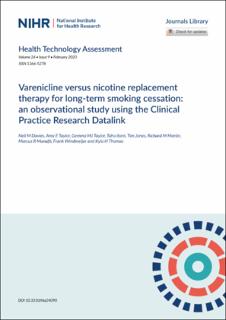Varenicline versus nicotine replacement therapy for long-term smoking cessation: an observational study using the Clinical Practice Research Datalink
Davies, Neil Martin; Taylor, Amy E.; Taylor, Gemma M.J.; Itani, Taha; Jones, Tim; Martin, Richard M.; Munafò, Marcus R.; Windmeijer, Frank; Thomas, Kyla H.
Peer reviewed, Journal article
Published version

Åpne
Permanent lenke
https://hdl.handle.net/11250/2995048Utgivelsesdato
2020Metadata
Vis full innførselSamlinger
Originalversjon
10.3310/hta24090Sammendrag
Background
Smoking is the leading avoidable cause of illness and premature mortality. The first-line treatments for smoking cessation are nicotine replacement therapy and varenicline. Meta-analyses of experimental studies have shown that participants allocated to the varenicline group were 1.57 times (95% confidence interval 1.29 to 1.91 times) as likely to be abstinent 6 months after treatment as those allocated to the nicotine replacement therapy group. However, there is limited evidence about the effectiveness of varenicline when prescribed in primary care. We investigated the effectiveness and rate of adverse events of these medicines in the general population.
Objective
To estimate the effect of prescribing varenicline on smoking cessation rates and health outcomes.
Data sources
Clinical Practice Research Datalink.
Methods
We conducted an observational cohort study using electronic medical records from the Clinical Practice Research Datalink. We extracted data on all patients who were prescribed varenicline or nicotine replacement therapy after 1 September 2006 who were aged ≥ 18 years. We investigated the effects of varenicline on smoking cessation, all-cause mortality and cause-specific mortality and hospitalisation for: (1) chronic lung disease, (2) lung cancer, (3) coronary heart disease, (4) pneumonia, (5) cerebrovascular disease, (6) diabetes, and (7) external causes; primary care diagnosis of myocardial infarction, chronic obstructive pulmonary disease, depression, or prescription for anxiety; weight in kg; general practitioner and hospital attendance. Our primary outcome was smoking cessation 2 years after the first prescription. We investigated the baseline differences between patients prescribed varenicline and patients prescribed nicotine replacement therapy. We report results using multivariable-adjusted, propensity score and instrumental variable regression. Finally, we developed methods to assess the relative bias of the different statistical methods we used.
Results
People prescribed varenicline were healthier at baseline than those prescribed nicotine replacement therapy in almost all characteristics, which highlighted the potential for residual confounding. Our instrumental variable analysis results found little evidence that patients prescribed varenicline had lower mortality 2 years after their first prescription (risk difference 0.67, 95% confidence interval –0.11 to 1.46) than those prescribed nicotine replacement therapy. They had similar rates of all-cause hospitalisation, incident primary care diagnoses of myocardial infarction and chronic obstructive pulmonary disease. People prescribed varenicline subsequently attended primary care less frequently. Patients prescribed varenicline were more likely (odds ratio 1.46, 95% confidence interval 1.42 to 1.50) to be abstinent 6 months after treatment than those prescribed nicotine replacement therapy when estimated using multivariable-adjusted for baseline covariates. Patients from more deprived areas were less likely to be prescribed varenicline. However, varenicline had similar effectiveness for these groups.
Conclusion
Patients prescribed varenicline in primary care were more likely to quit smoking than those prescribed nicotine replacement therapy, but there was little evidence that they had lower rates of mortality or morbidity in the 4 years following the first prescription. There was little evidence of heterogeneity in effectiveness across the population.